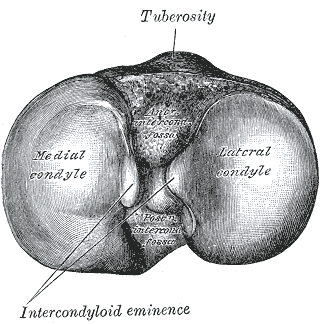Tibial plateau fracture pathophysiology
|
Tibial plateau fracture Microchapters |
|
Diagnosis |
|---|
|
Treatment |
|
Case Studies |
|
Tibial plateau fracture pathophysiology On the Web |
|
American Roentgen Ray Society Images of Tibial plateau fracture pathophysiology |
|
Risk calculators and risk factors for Tibial plateau fracture pathophysiology |
Editor-In-Chief: C. Michael Gibson, M.S., M.D. [1]; Associate Editor(s)-in-Chief: Rohan A. Bhimani, M.B.B.S., D.N.B., M.Ch.[2]
Overview
The pattern of fracture and degree of comminution are the resultant of several factors or variables such as the nature of injury, the bone quality, the age and weight of the patient, the energy involved, and the position of the knee and leg at the time of impact. Various combinations of these variables lead to a variety of different fracture patterns.
Pathophysiology
- The fracture pattern and severity of comminution depends on multiple factors including:[1]
- Decrease in bone mass density involves following process:[2]
- Autophagy is the mechanism through which osteocytes evade oxidative stress.
- The capability of autophagy in cells decreases as they age, a major factor of aging.
- As osteocytes grow, viability of cells decrease thereby decreasing the bone mass density.
Anatomy
 |
- Majority of the weight in the lower leg is transmitted through tibia.[3][4]
- The tibial plateau is the proximal portion of the tibia and forms the part of the knee joint.
- The stronger of the two articular surfaces is the medial tibial condyle whereas the lateral tibial condyle is a weaker portion of the joint.
- The medial from the lateral tibial condyle are separated by the intercondylar eminence which serves as the attachment for the anterior cruciate ligament (ACL).
Medial Condyle
- The medial condyle is larger than the lateral condyle.
- The articular surface of medial condyle is oval and it is long axis is anteroposterior.
- The central part of the medial condylar surface is slightly concave.
- The peripheral part is flat and separated from femoral condyle by the medial meniscus.
Lateral Condyle
- The lateral condyle overhangs the shaft of tibia.
- The articular surface is nearly circular.
- The central part is slightly concave and comes in direct contact with femoral condyle.
- The peripheral part is flat and separated from femur by the lateral meniscus.
Mechanism of Fracture
- Proximal tibial injuries can occur due to direct trauma or indirect mechanisms such as axial compression.[5]
- The causes of most tibial plateau fractures are a valgus stress associated with an axial load.
- Most tibial plateau fractures result from motor vehicle-related injuries followed by sports-associated injuries.
- The bumper of a car striking the lateral plateau during this vehicle–pedestrian-related injury causes a valgus mechanism of injury.
- Motor vehicle injuries are high energy and often result in splitting types of fractures as well as direct injury to the surrounding soft tissues.
- Low-energy forces can cause a tibial plateau fracture usually in older patients with poor bone quality due to rotational forces.
- Such injuries are primarily seen in women >50 years with osteoporosis resulting in a depressed pattern plateau fracture.
References
- ↑ Azar, Frederick (2017). Campbell's operative orthopaedics. Philadelphia, PA: Elsevier. ISBN 9780323374620.
- ↑ Onal M, Piemontese M, Xiong J, Wang Y, Han L, Ye S; et al. (2013). "Suppression of autophagy in osteocytes mimics skeletal aging". J Biol Chem. 288 (24): 17432–40. doi:10.1074/jbc.M112.444190. PMC 3682543. PMID 23645674.
- ↑ Rockwood, Charles (2010). Rockwood and Green's fractures in adults. Philadelphia, PA: Wolters Kluwer Health/Lippincott Williams & Wilkins. ISBN 9781605476773.
- ↑ Azar, Frederick (2017). Campbell's operative orthopaedics. Philadelphia, PA: Elsevier. ISBN 9780323374620.
- ↑ Ramponi DR, McSwigan T (2018). "Tibial Plateau Fractures". Adv Emerg Nurs J. 40 (3): 155–161. doi:10.1097/TME.0000000000000194. PMID 30059369.